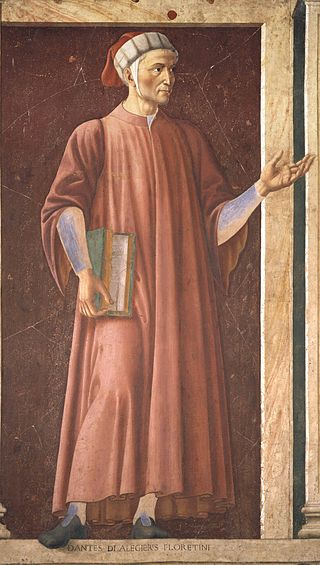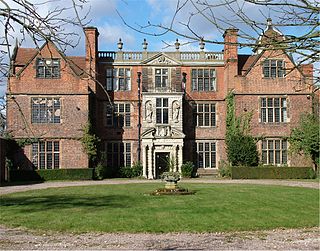
The Renaissance is a period in European history marking the transition from the Middle Ages to modernity and covering the 15th and 16th centuries, characterized by an effort to revive and surpass ideas and achievements of classical antiquity. It occurred after the Crisis of the Late Middle Ages and was associated with great social change. In addition to the standard periodization, proponents of a "long Renaissance" may put its beginning in the 14th century and its end in the 17th century.

The Italian Renaissance was a period in Italian history covering the 15th and 16th centuries. The period is known for the initial development of the broader Renaissance culture that spread across Western Europe and marked the transition from the Middle Ages to modernity. Proponents of a "long Renaissance" argue that it started around the year 1300 and lasted until about 1600. In some fields, a Proto-Renaissance, beginning around 1250, is typically accepted. The French word renaissance means "rebirth", and defines the period as one of cultural revival and renewed interest in Classical antiquity after the centuries during what Renaissance humanists labelled as the "Dark Ages". The Italian Renaissance historian Giorgio Vasari used the term rinascita ("rebirth") in his Lives of the Most Excellent Painters, Sculptors, and Architects in 1550, but the concept became widespread only in the 19th century, after the work of scholars such as Jules Michelet and Jacob Burckhardt.

Decorum was a principle of classical rhetoric, poetry, and theatrical theory concerning the fitness or otherwise of a style to a theatrical subject. The concept of decorum is also applied to prescribed limits of appropriate social behavior within set situations.
Ecclesiastical Latin, also called Church Latin or Liturgical Latin, is a form of Latin developed to discuss Christian thought in Late Antiquity and used in Christian liturgy, theology, and church administration down to the present day, especially in the Catholic Church. It includes words from Vulgar Latin and Classical Latin re-purposed with Christian meaning. It is less stylized and rigid in form than Classical Latin, sharing vocabulary, forms, and syntax, while at the same time incorporating informal elements which had always been with the language but which were excluded by the literary authors of Classical Latin.

The Northern Renaissance was the Renaissance that occurred in Europe north of the Alps. From the last years of the 15th century, its Renaissance spread around Europe. Called the Northern Renaissance because it occurred north of the Italian Renaissance, this period became the German, French, English, Low Countries, Polish Renaissances and in turn other national and localized movements, each with different attributes.

Loyset Compère was a Franco-Flemish composer of the Renaissance. Of the same generation as Josquin des Prez, he was one of the most significant composers of motets and chansons of that era, and one of the first musicians to bring the light Italianate Renaissance style to France.
Latin pronunciation, both in the classical and post-classical age, has varied across different regions and different eras. As the respective languages have undergone sound changes, the changes have often applied to the pronunciation of Latin as well.

Renaissance Latin is a name given to the distinctive form of Literary Latin style developed during the European Renaissance of the fourteenth to fifteenth centuries, particularly by the Renaissance humanism movement. This style of Latin is regarded as the first phase of the standardised and grammatically "Classical" Neo-Latin which continued through the 16th–19th centuries, and was used as the language of choice for authors discussing subjects considered sufficiently important to merit an international audience.

A pergola is most commonly an outdoor garden feature forming a shaded walkway, passageway, or sitting area of vertical posts or pillars that usually support cross-beams and a sturdy open lattice, often upon which woody vines are trained. The origin of the word is the Late Latin pergula, referring to a projecting eave.

The Italianate style was a distinct 19th-century phase in the history of Classical architecture. Like Palladianism and Neoclassicism, the Italianate style drew its inspiration from the models and architectural vocabulary of 16th-century Italian Renaissance architecture, synthesising these with picturesque aesthetics. The style of architecture that was thus created, though also characterised as "Neo-Renaissance", was essentially of its own time. "The backward look transforms its object," Siegfried Giedion wrote of historicist architectural styles; "every spectator at every period—at every moment, indeed—inevitably transforms the past according to his own nature."

The Jacobean style is the second phase of Renaissance architecture in England, following the Elizabethan style. It is named after King James VI and I, with whose reign it is associated. At the start of James' reign there was little stylistic break in architecture, as Elizabethan trends continued their development. However, his death in 1625 came as a decisive change towards more classical architecture, with Italian influence, was in progress, led by Inigo Jones; the style this began is sometimes called Stuart architecture, or English Baroque.

The Renaissance in Poland lasted from the late 15th to the late 16th century and is widely considered to have been the Golden Age of Polish culture. Ruled by the Jagiellonian dynasty, the Crown of the Kingdom of Poland actively participated in the broad European Renaissance. The multinational Polish state experienced a period of cultural growth thanks in part to a century without major wars, aside from conflicts in the sparsely-populated eastern and southern borderlands. The Reformation spread peacefully throughout the country, and living conditions improved, cities grew, and exports of agricultural products enriched the population, especially the nobility (szlachta), who gained dominance in the new political system of Golden Liberty.

Renaissance Revival architecture is a group of 19th century architectural revival styles which were neither Greek Revival nor Gothic Revival but which instead drew inspiration from a wide range of classicizing Italian modes. Under the broad designation Renaissance architecture nineteenth-century architects and critics went beyond the architectural style which began in Florence and Central Italy in the early 15th century as an expression of Renaissance humanism; they also included styles that can be identified as Mannerist or Baroque. Self-applied style designations were rife in the mid- and later nineteenth century: "Neo-Renaissance" might be applied by contemporaries to structures that others called "Italianate", or when many French Baroque features are present.

The Isabelline style, also called the Isabelline Gothic, or Castilian late Gothic, was the dominant architectural style of the Crown of Castile during the reign of the Catholic Monarchs, Queen Isabella I of Castile and King Ferdinand II of Aragon in the late-15th century to early-16th century. The Frenchman Émile Bertaux named the style after Queen Isabella.
Renaissance architecture was that style of architecture which evolved firstly in Florence and then Rome and other parts of Italy as the result of Renaissance humanism and a revived interest in Classical architecture. It was part of the general movement known as the Italian Renaissance, which spread outwards from Italy and effected many aspects of scholarship and the arts. When the Renaissance spirit was exported into Eastern Europe, it had to compromise with local traditions and climates. The Renaissance style differs from place to place throughout the region with many local characteristics making themselves apparent.
Latino or Latinos refers to:

Architectural revivalism is the use of elements that echo the style of a previous architectural era that have or had fallen into disuse or abeyance between their heyday and period of revival. Revivalism, in a narrower sense, refers to the period of- and movement within- Western architectural history during which a succession of antecedent and remenescent styles were taken to by architects, roughly from the late 18th century, and which was itself succeeded by Modernism. Notable revival styles include Neoclassical architecture, and Gothic Revival. Revivalism is related to historicism.
Nationality words link to articles with information on the nation's poetry or literature.

Palazzo style refers to an architectural style of the 19th and 20th centuries based upon the palazzi (palaces) built by wealthy families of the Italian Renaissance. The term refers to the general shape, proportion and a cluster of characteristics, rather than a specific design; hence it is applied to buildings spanning a period of nearly two hundred years, regardless of date, provided they are a symmetrical, corniced, basemented and with neat rows of windows. "Palazzo style" buildings of the 19th century are sometimes referred to as being of Italianate architecture, but this term is also applied to a much more ornate style, particularly of residences and public buildings.
Hellenization in the Byzantine Empire describes the spread and intensification of ancient Greek culture, religion and language in the Byzantine Empire. The theory of Hellenization generally applies to the influence of foreign cultures subject to Greek influence or occupation, which includes the ethnic and cultural homogenisation which took place throughout the life of the Byzantine Empire (330-1453).













